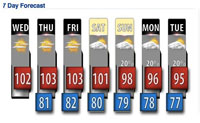Scorched in Texas
Hallie Moore Guest Blogger 2010

Our plants were producing, looking healthy and green, and we were enjoying, literally, the fruits of our labor. That was in May/June, when the Texas summer was enjoyable and temperatures were topping out in the low 90s. Well, that time has passed.
Come July and now into August, the weekly forecast has all days in the triple digits. Our newly planted grass in the backyard is turning brown and our plants are suffering from the heat and intense sun.
We have had to watch and wait and water and wait and watch some more as our plants, no matter what we try and do, turn brown and wilt away. The only plants that seems to be handling the heat are the peppers. Go figure.
As the novice gardeners that we are, and newcomers to this Texas summer (it’s our first summer here) we had no idea what kind of battle we would be in for. And battling we are.
The tomatoes have pretty much stopped producing anything. Every now and then we get a couple cherry tomatoes that we can salvage and eat but our large tomatoes are just not growing. Sad but true.
At this point, we are trying to determine if we should just call it quits on this summer’s veggie garden or keep fighting and duking it out with the heat that doesn't seem to be backing down anytime soon.
For now … we will keep our boxing gloves on and do what we can to keep our veggies alive. Here's to a break in the heat sometime soon.